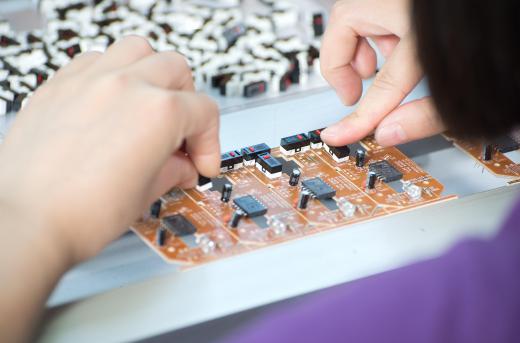Printed circuit board (PCB) prototype assembly is nearly identical to assembling a full run of PCBs, with the biggest difference being the number of PCBs being used. Many of the parts generate heat in a PCB, so the inventor should listen to the manufacturer’s instructions about part spacing in PCB prototype assembly. Most PCBs are made to fulfill a certain task, and optimizing the PCB for that task can strengthen the prototype. When performing PCB prototype assembly, it normally is best to leave some room around the edge for safety reasons. Some parts in a PCB have to be placed in a specific area, and it can be easier to place these parts first.
While a prototype PCB is one that is not on the market, there generally are many commercially available parts used to assemble a prototype PCB. Many of those parts come with manufacturer’s instructions indicating how far apart from one another the parts should be placed to ensure that heat generated by each part does not destroy nearby components. It normally is best to follow this during PCB prototype assembly; otherwise, the board may have a very short lifespan.

Picking the parts for PCB prototype assembly should be done based on need and functionality to ensure the PCB is optimized for the task it is meant to do. For example, if a PCB is meant to increase processing speeds, then using components that best integrate with the central processing unit (CPU) should be chosen. This should help the PCB work correctly, and it often makes the task of picking parts easier.
The inventor is capable of filling the inside area of the PCB to the edge with components, but this can be a bad idea. During PCB prototype assembly, the inventor should leave a border of around 2.5 millimeters free of any parts. If there are components near the edge, then they are less resistant to heat, and any shock to the edge of the PCB may physically damage the components and ruin the PCB.
Most parts used in PCB prototype assembly can be placed anywhere, but there are some that need to be placed in a specific spot. While not required, it normally is easier to place these parts first. This makes it easier to plan where the other parts go, and it ensures that these parts get their specific spot before others parts fill up those zones.
